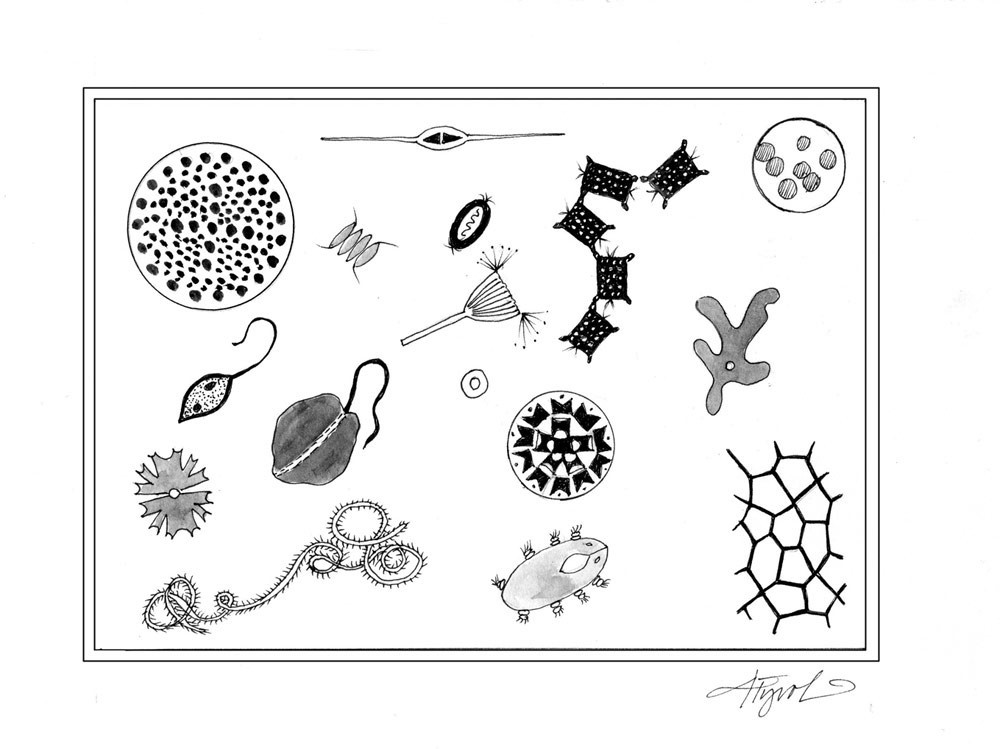
City dwellers and puddles don’t mix; we country folk are more tolerant. In wet weather we drive through one muddy morass after the next, uttering unprintable words, yet few of us would exchange dirt-spattered windows, packed wheel wells and a caked undercarriage for a commute on smooth asphalt in Flatland.
How about 5-year-olds and their affinity for adventure? An inspired flat-footed leap into a chocolate-colored puddle is an experience to be treasured. It’s beyond sublime to land happily into such murky water.
If little people love puddles, so do much littler critters. A puddle is a universe for small creatures, but often it’s difficult finding the inhabitants—even when their lives are in full bloom. To see what’s present, you will often need a microscope.
Obviously there are bacteria. And there are larger one-celled protozoa now active after a long winter’s shut-down inside their resistant cysts. The mud also harbors both amoebas and busy ciliates that are smaller than the familiar paramecia remembered from school days.
As the season continues warming, a tinge of green appears at a puddle’s margin, signifying a bloom of photosynthetic flagellates much smaller than euglena, another traditional lab specimen. We come across rotifers, tiny multi-celled creatures just awakened from their encapsulated over-wintering state. A wriggling hair-spring roundworm—a nematode—writhes in and out of the flocculent carpeting on a puddle floor.
These little animals may not have an easy time in flooded roads saturated with contaminants; the most sensitive creatures don’t make it in those puddles.
In New Hampshire and Vermont, though, there are many one-time logging roads that now are no more than muddy tracks relatively free of contaminants. Each spring I inspect the edge of our lower meadow where logging occurred years ago. A skidder sank to its hubs in saturated soil back then, leaving two long, deep depressions that fill with groundwater.
Looking down, I see the slow-motion gyrations of gordian worms, slender threadlike creatures several inches long. Because they ball up into confusing tangles, they were named after the puzzling Gordian Knot slashed by Alexander the Great. Why do they gather in this skidder puddle? And what are these gyrations?
Their stiff and deliberate writhings are an aquatic mating dance performed only in water. The fertilized eggs of the gordian worm eventually hatch into microscopic larvae, each equipped with a spiny proboscis that it uses to penetrate the tough cuticle of a grasshopper, cricket or beetle that arrives at the puddle to drink. As parasites the larvae wind up deep in an insect’s circulatory system, where they develop into adults that will later emerge and drop free only when their host is near water, thus completing a life cycle.
With their wings slowly unfolding and closing in quiet rhythms, flocks of skippers and other butterflies crowd a puddle, each uncoiling its proboscis into the water to slake its thirst and supplement its diet with the minerals that occur naturally in the shallow, still water.
Dauber wasps are at the puddle too, rolling up pellets of mud that they’ll use to construct cylindrical nests under eaves or in a hollow tree. Earlier this spring the robin stopped there to gather mud to build its cup nest, which it strengthens with interwoven grass and twigs. Footprints of tiger beetles are seen at the soft edge of the puddle, where they probably came to find prey.
Puddles with mossy edges are likely to harbor microscopic tardigrades (water bears). When desiccation threatens, the tardigrade shrivels up inside its skin, which serves as a protective envelope. Later—sometimes after several years of suspended animation—a tardigrade rejuvenates, returning to active life.
Different kinds of puddles invite exploration by humans. On Wheeler Mountain, near my home in St. Johnsbury, Vt., I once sat on a rock dome, with a field microscope in hand, to examine water from a shallow foot-long puddle cradled in the granite. Hundreds of a single species of rotifer were swimming through my magnified circular field. The mountaintop puddle lasted only a few days before drying up and leaving only a powdery deposit on the bottom. Countless rotifer cysts wound up lying in that dust, and there were no other signs of life. I scraped up these cysts, took them home, dumped them into a container of spring water, and watched them spring back to life.
Where do mountain puddle rotifers come from? Where might they go? When evaporation and drying-up threaten, rotifers form a cyst wall to protect against whatever the world throws at them. A breeze comes along, and the tiny cysts are whirled aloft to travel vast distances, perhaps even settling down in Germany or Japan.
Why inspect puddles? Understanding more about our world, even a muddy speck, is always fun if not instructive. Consider a mud puddle, and marvel at our own tiny place in the universe.


Discussion *